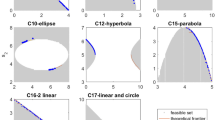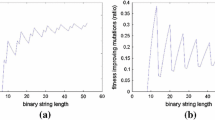Abstract
In this article, a dynamic Principal–Agent model with discrete actions is analysed from a Multi-Objective optimization framework. As a result, a concave Pareto Frontier is numerically approximated. The concavity of the Pareto Frontier is a consequence of the information asymmetry between the Principal and the Agent. The underlying Multi-Objective framework allows us to consider more powerful assumptions than those used in the traditional Single-Objective optimization approach. As contracts move in the Pareto Frontier (trade-off surface) towards those that are more advantageous to the Agent, the prevalence of compensation plans in which the Principal assumes most of the risk of the productive activity are observed. When the Principal and the Agent are more patient, both obtain higher values of their discounted expected utilities, which generates a higher level of economic surplus. The Agent faces lower variability in future compensation when it is costlier for him to exert an additional effort unit. Finally, a new Multi-Objective Evolutionary Algorithm (MOEA) is proposed in this article to approximate Pareto Frontiers, such algorithm involves an innovative ranking-mutation mechanism which promotes approximations with good spread, achieving even better results that some obtained by already well known MOEAs.
Similar content being viewed by others
References
Cervantes J., Stephens C. R. (2006) A rank proportional generic genetic algorithm. Lecture Series on Computer and Computational Sciences. Brill Academic Publishers, Leiden, The Netherlands, pp 71–74
Cervantes J., Stephens C. R. (2009) Limitations of existing mutation rate heuristics and how a Rank GA overcomes them. IEEE Transactions on Evolutionary Computation 13: 369–397
Coello C. A., Van Veldhuizen D. A., Lamont G. B. (2009) Evolutionary algorithms for solving multi-objective problems. Kluwer, Boston
Deb, K. (2000). An efficient constraint handling method for genetic algorithms. Computer Methods in Applied Mechanics and Engineering, 186, 311–338
Deb, K., Agrawal, S., Pratab, A., & Meyarivan, T. (2000). A fast elitist non-dominated sorting genetic algorithm for multi-objective optimization: NSGA-II. Technical report KanGAL-200001, Indian Institute of Technology, Kanpur, India.
Demougin D., Helm C. (2006) Moral hazard and bargaining power. German Economic Review 7: 463–470
Edgeworth F. Y. (1881) Mathematical psychics: An essay on the application of mathematics to the moral sciences. C. Kegan Paul and Co, London
Fernandes A., Phelan C. (2000) A recursive formulation for repeated agency with history dependence. Journal of Economic Theory 91: 223–247
Fonseca C., Fleming P. (1998) Multiobjective optimization and multiple constraint handling with evolutionary algorithms—part ii application example. IEEE Transactions on Systems, Man and Cybernetics, Part A 28: 38–47
Fonseca, C., & Fleming, P. J. (1993). Genetic algorithms for multiobjective optimization: Formulation, discussion and generalization. In S. Forrest (Ed.), Proceedings of the Fifth International Conference on Genetic Algorithms, Urbana-Champaign, IL, pp. 416–423.
Fourman, M. P. (1985). Compaction of symbolic layout using genetic algorithms. In Genetic Algorithms and Their Applications: Proceedings of the First International Conference on Genetic Algorithms, Pittsburgh, PA, pp. 141–153.
Goldberg D. E. (1989) Genetic algorithms in search. Optimization and machine learning. Addison-Wesley, Boston
Hansen, M. P., & Jaszkiewicz, A. (1998). Evaluating the quality of approximations to the non-dominated set. Technical report IMM-REP-1998-7, Technical University of Denmark, Lyngby, Denmark.
Holmstrom, B. (1979). Moral hazard and observability. Bell Journal of Economics, 10, 74–91
Judd K. L. (1998) Numerical methods in economics. MIT, Cambridge, MA
Knowles, J. D., & David, W. C. (1999). The Pareto archived evolution strategy. A new baseline algorithm for multiobjective optimisation. In Proceedings of the Congress on Evolutionary Computation, Washington, DC, pp. 95–105.
Knowles, J. D., Thiele, L., & Zitzler, E. (2006). A tutorial on the performance assessment of stochastic multiobjective optimizers. Technical Report 214, Computer, Engineering and Communication Networks Lab (TIK), Swiss Federal Institute of Technology (ETH), Zurich, Switzerland.
Koopmans T. C. (1951) Analysis of production as an efficient combination of activities. In: Koopmans T. C. (ed) Activity analysis of production and allocation, 13, Cowles Commission Monographs. Wiley, New York, pp 33–97
Kuhn H. W., Tucker A. W. (1951) Non-linear programming. In: Neyman J. (ed) Second Berkeley Symposium on Mathematical Statistics and Probability. University of California Press, Berkeley, CA
Lizárraga, G., Hernández, A., & Botello, S. (2007). G–Metric: An M–ary quality indicator for the evaluation of non–dominated sets. In Proceedings of the Genetic and Evolutionary Computation Conference (GECCO 2007), London, pp. 665–672.
Pareto V. (1896) Cours d’Economie Politique. F. Rouge and Co, Lausanne, Switzerland
Rubinstein, A. (1982). Perfect equilibrium in a bargaining model. Econometrica, 50, 97–109
Schaffer, D. (1985). Multiple objective optimization with vector-evaluated genetic algorithms. In International First Conference on Genetic Algorithms and their Applications, Pittsburgh, PA, pp. 93–100.
Spear, S., & Srivastava, S. (1987). On repeated moral hazard with discounting. Review of Economic Studies, 54, 599–617
Van Veldhuizen, D. (1999). Multiobjective evolutionary algorithms: Classifications, analyses, and new innovations. Ph.D. thesis, Department of Electrical and Computer Engineering, Graduate School of Engineering, Air Force Institute of Technology, Wright-Patterson AFB, OH.
Veldhuizen, D., & Lamont, G. B. (1998). Evolutionary computation and convergence to a Pareto frontier. Conference in Genetic Programming. Stanford Bookstore, Stanford, CA, pp. 221–228.
Wang, C. (1997). Incentives, CEO compensation, and shareholder wealth in a dynamic agencymodel. Journal of Economic Theory, 76, 72–105
Zitzler, E., Laumanns, M., & Thiele, L. (2001). SPEA2: improving the strength Pareto evolutionary algorithm. Technical Report 103, Computer Engineering and Networks Laboratory (TIK), Swiss Federal Institute of Technology (ETH), Zurich, Switzerland.
Zitzler, E., & Thiele, L. (1998). An evolutionary algorithm for multiobjective optimization: The strength Pareto approach. Technical Report 43, Computer Engineering and Communication Networks Lab (TIK), Swiss Federal Institute of Technology (ETH), Zurich, Switzerland.
Zitzler, E., Thiele, L., Laumanns, M., Fonseca, C., & Grunert, V. (2003). Performance assessment of multiobjective optimizers: An analysis and review. IEEE Transactions on Evolutionary Computation, 7, 117–132
Author information
Authors and Affiliations
Corresponding author
Rights and permissions
About this article
Cite this article
Curiel, I.T.Q., Di Giannatale, S.B., Herrera, J.A. et al. Pareto Frontier of a Dynamic Principal–Agent Model with Discrete Actions: An Evolutionary Multi-Objective Approach. Comput Econ 40, 415–443 (2012). https://doi.org/10.1007/s10614-011-9307-6
Received:
Accepted:
Published:
Issue Date:
DOI: https://doi.org/10.1007/s10614-011-9307-6




